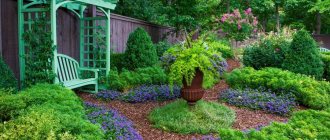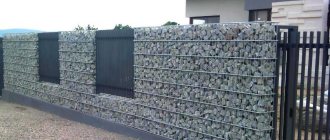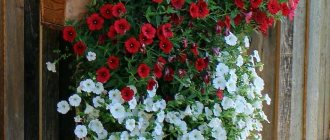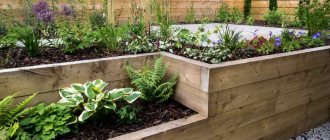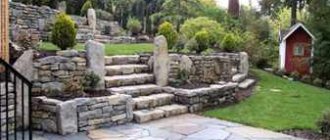Many homeowners today are creating unusual flower beds in their summer cottages. A flowerbed made of mesh and stones with your own hands is not only one of the many options for decorating the territory. This is both an opportunity to express yourself as a creative person and a chance to significantly save on invited specialists.
Flowerbeds made of stones in a steel mesh are designed for lovers of industrial design.
Recently, more and more often customers are interested in a variety of volumetric flower beds, which cannot be made without stones of various sizes, shapes, textures and colors. The combination of this durable and “harsh” natural material with fragile plants sometimes creates amazing micro-landscapes that make a lasting impression.
It is worth thinking about creating such a decorative object. And if there are remains of construction netting on the farm, you should not rush to throw it away.
Gabions and their general structure
A conversation about building flower beds using mesh should start with such a thing as a gabion. This term comes from the French language and is translated literally as “stones in nets.”
Having emerged as an installation technique for strengthening mountain slopes, embankments, roads and other objects, gabions gradually migrated into the sphere of advanced garden and country design.
Currently, this simple technology is successfully used on private plots to form decorative flower bed fences, various small architectural forms such as garden tables or benches, and original fences. Moreover, such designs look very beautiful in almost any combination. You just need to choose the right source material from the many known species.
Types of stones for building a decorative flower garden
Scheme of laying a box-shaped gabion.
The following materials are very popular among experienced specialists in the field of landscape design:
- Porous limestone. It is interesting for its texture, characterized by a large number of faults. Mosses take root well on it - a beautiful addition to the herbaceous and floral base of the flower bed.
- Tuff. It is a light, cemented variety of limestone.
- Sandstone. Thanks to its breathable stone properties, sandstone provides optimal ventilation for plant roots. With all its advantages, this material has one significant disadvantage: it is short-lived.
- Basalt. Refers to volcanic rocks. It has excellent strength, as well as resistance to mechanical loads and various aggressive environments.
- Slate (gneiss). It comes in the form of plates of various colors. This property makes it an excellent decorative stone.
- Quartz. One of the most common minerals on the planet. It has remarkable decorative potential due to its “glass” texture.
- Granite. A very durable and beautiful stone, which is used both in the construction of buildings and in the creation of various design projects. However, this material is quite expensive and is not so often used when arranging flower beds, unlike the stones presented above.
Nuances of choosing material
The choice of material for the implementation of a planned project mainly comes down to personal preferences and financial capabilities. It is important to decide in advance whether the stones will play a dominant role in the composition or become a secondary element of the flower bed. The stones do not have to be laid in a strict order; it would be more correct to arrange them a little chaotically. Do not forget about the importance of the overall impression after the construction of the structure. The creation must fit into the unified style of landscape design and have details that resonate with the surrounding environment. Along with individual creativity, technical principles must be adhered to and a certain balance must be maintained.
The larger the stone flowerbed is planned, the larger its elements should be, but you need to understand that massive specimens in a small garden will seem like alien heaps. Rough blocks of arbitrary, broken, angular shape, with sharp edges and edges are more appropriate for a high embankment. Small boulders with smooth, rounded outlines and a smooth surface are better suited for making compact miniatures.
For a rocky garden using the “Czech rolling pin” scheme, rocks of sedimentary origin are chosen - flat limestone, sandstone, flagstone, slate
Imitation of natural rocks has its advantages in the form of a uniform shape and a wide color palette, which simplifies the work, but masonry made from natural materials undoubtedly looks more natural and aesthetically pleasing. In addition, artificial analogues often have a higher cost. A fairly budget-friendly landscape masterpiece will be made from rock fragments, river boulders, sloping pebbles and other natural stones, mined and collected independently, and then folded into an organic composition.
If you plan to decorate the flowerbed with ground-blooded or climbing plants, then it is better to prefer stones with a rough, loose surface, which will allow the shoots to easily cling and climb in different directions. It must be borne in mind that pieces of light-colored wild rocks that have a soft porous structure ( volcanic tuff, shell rock, sandstone ) absorb moisture and over time become clogged with dust contaminants, due to which they can change color and become covered with moss and lichens. Under the influence of temperature changes and atmospheric phenomena, they quickly begin to crumble and partially break off.
White color is too dominant and capricious, it takes all the emphasis on itself, drowning out the “sound” of the entire ensemble. Design experts do not recommend using it in large quantities.
In a minimalist design, pieces of the same type of rock are often combined, adding variety due to their size
The smooth, shiny texture of noble granite, gneiss, quartzite, and cobblestone shimmers wonderfully in the sun, reflecting the rays, but at the same time it heats up during the day and quickly cools down at night, which certainly affects the root system of plants planted nearby.
It would be useful to pay attention to the properties of materials that have a gradual effect on the composition of the soil. Thus, granite can slightly acidify the soil in a limited area, and limestone can alkalize.
How to make a single-level and multi-level flowerbed with your own hands
Considering the large weight of the stones used, a high-quality durable metal mesh is required to create gabions.
In a one-level flowerbed, as you might guess, all the plants are on the same level. This is the simplest option for arranging decorative flora. By choosing a multi-level flowerbed from a mesh, the owner of a summer cottage provides himself with a much more interesting object in an artistic sense.
First of all, you should prepare a design for the future flower bed on paper. Then the outlines of the planned walls (base) are transferred to the ground. This can be done using pegs driven into the soil and marking string. You can also simply draw the boundaries of the gabion stone borders on a piece of land.
After this, using cutters and pliers, in accordance with the boundaries of the future structure marked, the building grid is given the desired configuration. It could be a star, spiral, rectangle, circle or any other geometric shape.
The mesh should be bent so that it forms 2 walls. Bent according to a given pattern (ordinary wire can be used to fix the decorative silhouette), it is installed on the site of the future flower bed. The lower edges of the mesh are slightly buried in the ground.
The opening formed in this way between the two walls of the mesh (gutter) is filled with prepared stones. In this case, it is necessary to ensure that the stone filler is not smaller in size than the mesh cell. Otherwise, the stones will not stay inside the structure.
Valuable qualities of bulk structures
Gabion structures have many advantages:
- they are easy to erect and just as easy to dismantle;
- can be disassembled and moved to a new location if necessary;
- look aesthetically pleasing and are widely used for decorative purposes;
- They are very strong, durable, successfully perform their protective functions during landslides and floods, and also reliably hide the territory from prying eyes if the structure is high enough. At the same time, the structures are breathable;
- You can easily hide garden hoses and pipes between the stones and lay wiring;
- environmentally friendly - this is one of the important qualities of gabions. Such structures do not harm the environment.
Even after the mesh collapses, the retaining structures will retain their shape for an additional 90 years.
How to make a vertical flower bed and a vertical stand
To create a gabion, a main cylindrical frame is made from mesh.
In order to make a high-quality vertical flower garden, you need to prepare a net, a pot, seedlings and fabric.
The main cylindrical frame is made from mesh. The fabric is placed inside the cylinder. A pot with seedlings is placed at the bottom of the structure.
Pre-prepared stones are laid along the edge of the mesh. They should form a border in one layer. The space inside the border, in the center of which the pot is installed, is filled with soil. If necessary, soil should be added and watered to compact it.
Thus, by arranging subsequent levels of stone border and adding soil, the flowerbed increases in height. At the final stage, the fabric is cut in several places - where the plants will be planted.
It should be especially noted that the vertical stand is intended only for planting flower plants. To create it, in addition to the mesh, you will need several polyethylene sheets. Using the tools mentioned above, a decorative silhouette is formed from the mesh.
After installing the finished mesh structure, polyethylene is mounted inside it. This must be done in such a way that the soil can be sprinkled between the sheets of polyethylene. After installation is completed and the soil is filled, flowers are planted inside the stand.
Limestone
A rock with a loose porous structure is good because it is easy to process - it can be split or even cut with a grinder. It can be light in different shades - from ivory and pearl gray to yellowish and pink.
Advantages of flower beds made of stones and mesh
Due to shrinkage, gabions only become stronger over time.
The technology under consideration has a number of advantages, among which the following stand out:
- construction mesh, as a fairly flexible material, can easily be given almost any configuration;
- This design is not susceptible to seasonal ground movements;
- densely filled with stone material, such flower beds have excellent water resistance;
- due to shrinkage, stone flower beds only become stronger over time;
- stone-mesh flowerbeds do not spoil the pristine nature of the surrounding landscape;
- such objects are built quickly enough and without the use of special construction equipment;
- A properly constructed flowerbed made of stones and mesh does not require constant care.


